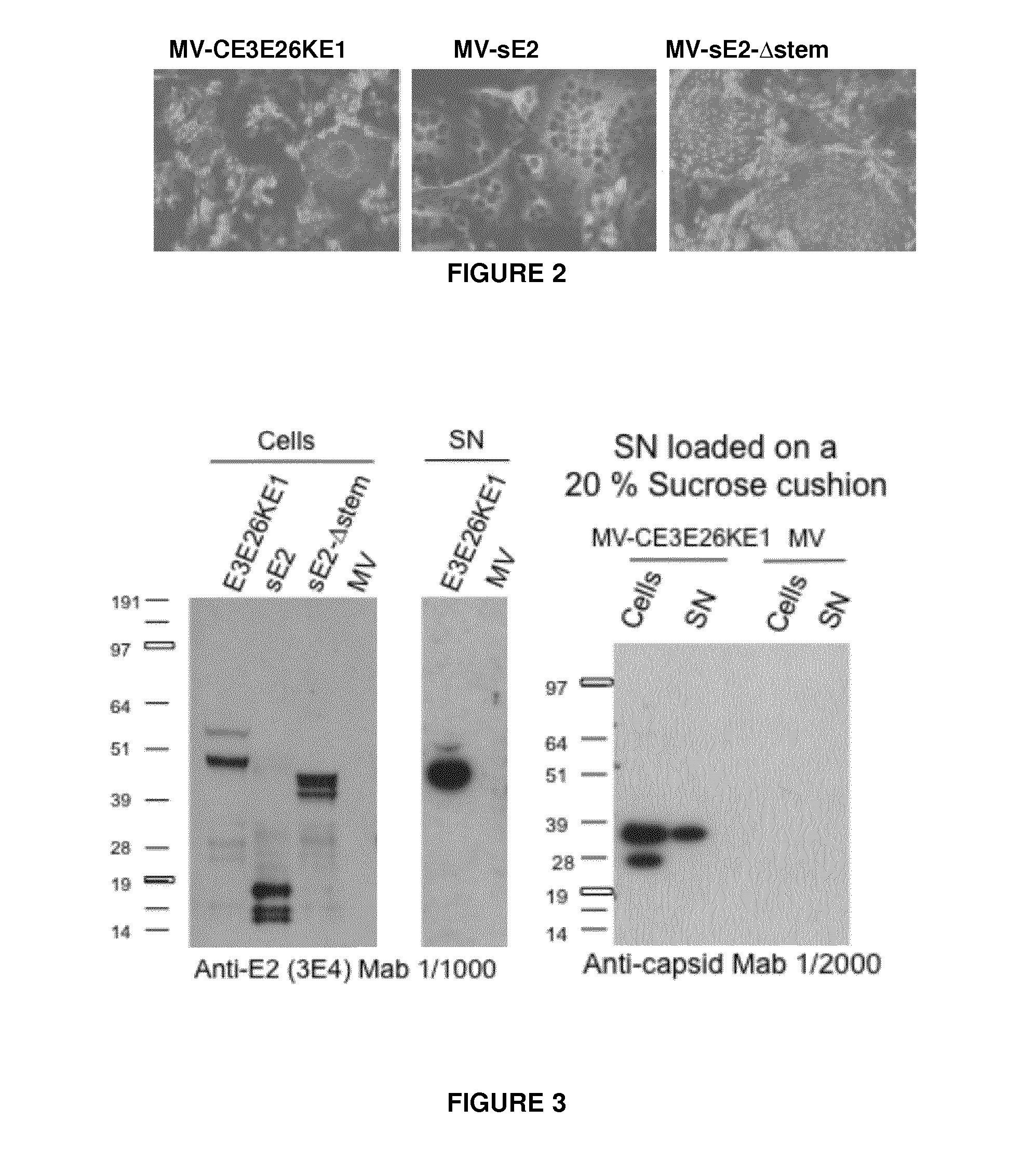Recombinant measles virus expressing chikungunya virus polypeptides and their applications
a technology of chikungunya virus and polypeptides, which is applied in the field of recombinant measles virus expressing chikungunya virus polypeptides, can solve the problems of high amount of antigen required for mass immunization, raising safety issues, and vaccines are still questionabl
- Summary
- Abstract
- Description
- Claims
- Application Information
AI Technical Summary
Benefits of technology
Problems solved by technology
Method used
Image
Examples
examples
Construction and Characterization of Recombinant Measles Virus Vectors Expressing Chikungunya Virus Proteins.
[0168]The inventors designed three Chikungunya Virus antigens based on peptide sequences from native proteins of the strain 06-49 of Chikungunya virus. The native proteins enabling preparation of these peptide sequences were the five structural proteins which consist of capsid (C) envelope and accessory proteins E1, E2, E3 and 6K.
[0169]The first construct was directed to the expression of the soluble form of the envelope protein E2 (sE2), the second construct to the expression of the sE2 without the stem region (sE2Δstem), and the third construct was directed to the expression of all viral structural proteins (C-E3-E2-6K-E1) (FIG. 1). The experiment protocols have been described herein with respect to this latter construct.
[0170]Cell culture. Vero (African green monkey kidney) cells were maintained in DMEM GlutaMAX™ (Gibco-BRL) supplemented with 5% heat-inactivated fetal calf...
experiment 1
Analysis of the Immunogenicity and the Protective Efficacy of Measles Virus-CE3E26KE1 Recombinant Viruses in CD46-IFNAR Mice.
[0191]Six-week-old CD46-IFNAR mice susceptible to Measles virus infection were intraperitoneally inoculated with 2.104 TCID50 of Measles virus—Chikungunya virus recombinant viruses and boosted 1 month later with the same dose of recombinant viruses. Control mice were immunized with the same dose of empty Measles virus Schwarz vector (MV Schw). For antibody determination, blood samples were collected via the periorbital route 1 month after the first inoculation, then at 2 weeks after boosting. Mice were then challenged by i.p. injection of 100 pfu of Chikungunya virus 06-49 strain for evaluating protection (Immunization and challenge schedule is given in FIG. 7).
[0192]To evaluate the specific antibody responses, mice were bled at different time-points after inoculation. Sera were heat inactivated at 56° C. for 30 min and anti-Chikungunya virus antibodies were d...
experiment 2
Analysis of the Immunogenicity and the Protective Efficacy of a Single Dose of Measles Virus-CE3E26KE1 Recombinant Virus in CD46-IFNAR Mice.
[0195]Six-week-old CD46-IFNAR mice were i.p. inoculated with 105 TCID50 of Measles virus-CE3E26KE1 recombinant viruses. Control mice were immunized with the same dose of empty Measles virus Schw vector. Blood samples were collected via the periorbital route 2 weeks after immunization for antibody determination, and then mice were challenged by i.p. injection of 100 pfu of Chikungunya virus 06-49 (Immunization and challenge schedule is given in FIG. 9).
[0196]The Measles virus-CE3E26KE1 recombinant viruses induced high antibody titers after a single injection (table 2—FIG. 10), and neutralizing titers that were sufficient to confer protection against a lethal challenge with 100 PFU of Chikungunya virus-06-49 in IFNAR mice.
TABLE 2Antibody response elicited in CD46-IFNAR mice aftera single immunization with MV-CE3E26KE1 virusMVCHIKVElisaElisaCHIKVCH...
PUM
| Property | Measurement | Unit |
|---|---|---|
| diameter | aaaaa | aaaaa |
| total volume | aaaaa | aaaaa |
| total volume | aaaaa | aaaaa |
Abstract
Description
Claims
Application Information
 Login to View More
Login to View More - R&D
- Intellectual Property
- Life Sciences
- Materials
- Tech Scout
- Unparalleled Data Quality
- Higher Quality Content
- 60% Fewer Hallucinations
Browse by: Latest US Patents, China's latest patents, Technical Efficacy Thesaurus, Application Domain, Technology Topic, Popular Technical Reports.
© 2025 PatSnap. All rights reserved.Legal|Privacy policy|Modern Slavery Act Transparency Statement|Sitemap|About US| Contact US: help@patsnap.com



